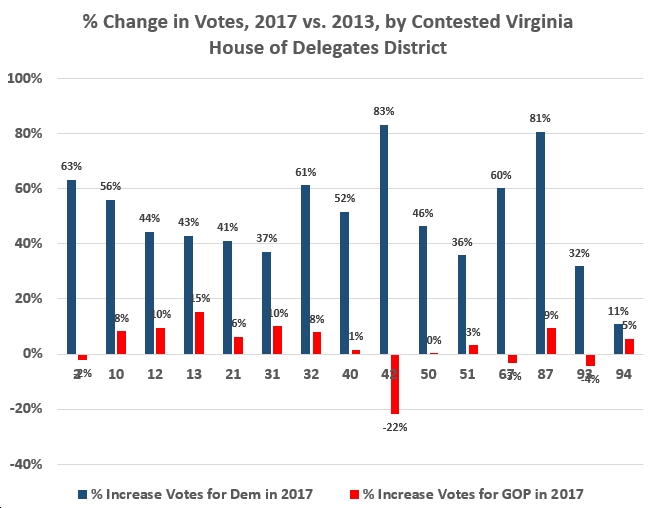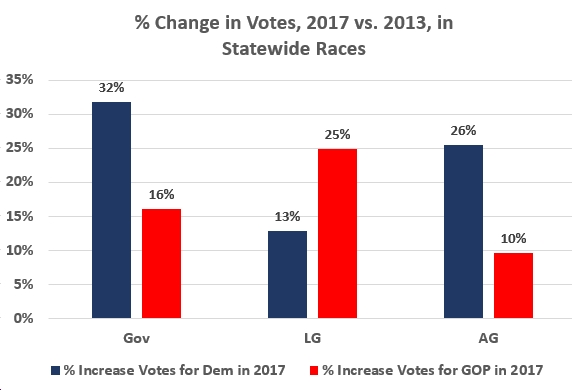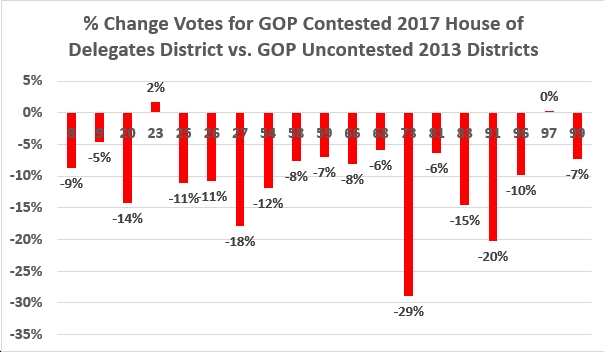In comparing 2017 to 2013 results for Virginia House of Delegates races, I wasn’t sure anything interesting would pop out, but as it turns out, it very much did.
For instance, check out the first graph, below, which looks at 15 House districts that were contested between Democrats and Republicans in both 2013 and 2017. Note that in 2013, Democrats won the 2nd (Michael Futrell over Republican Mark Dudenhefer), while losing the 10th (Republican Del. Randy Minchew over Democrat Monte Johnson), losing the 12th (Republican Del. Joseph Yost over Democrat James Harder), losing the 13th (Republican Del. Bob Marshall over Democrat Atif Qarni), losing the 21st (Republican Del. Ron Villaneuva over Democrat Susan Hippen), losing the 31st (Republican Del. Scott Lingamfelter over Democrat Jeremy McPike), losing the 32nd (Republican Del. Tag Greason over Democrat Elizabeth Miller), losing the 40th (Republican Del. Tim Hugo over Democrat Jerry Foltz), losing the 50th (Republican Del. Jackson Miller over Democrat Richard Cabellos), losing the 51st (Republican Del. Rich Anderson over Democrat Reed Heddleston, losing the 67th (Republican Del. Jim LeMunyon over Democrat Hung Nguyen), losing the 87th (Republican Del. David Ramadan over Democrat John Bell), winning the 93rd (Democrat Monty Mason over Republican Mike Watson) and losing the 94th (Republican Del. David Yancey over Democrat Rob Farinholt). Lots of losing there, sad to say.
But fortunately…what a difference four years made! See below the graph for more on that dramatic story…

So, four years later, what happened was that Democrats went wild, winning the 2nd (Jennifer Carroll Foy), winning the 10th (Wendy Gooditis), winning the 12th (Chris Hurst), winning the 13th (Danica Roem), winning the 21st (Kelly Fowler), winning the 31st (Elizabeth Guzman), winning the 32nd (David Reid), winning the 42nd (Kathy Tran), winning the 50th (Lee Carter), winning the 51st (Hala Ayala), winning the 67th (Karrie Delaney), winning the 87th (John Bell), and winning the 93rd (Mike Mullin), while the 40th and 94th are so close that they are headed to recounts.
What caused such a dramatic turnaround for the “blue team?” First and foremost, Donald Trump is now “president” (loosely speaking), and that: a) helped motivate a slew of talented Democrats to step up and run; b) helped motivate many others to step up and take a lead in “the resistance” to Trump; c) drove Democratic turnout up sharply compared to 2013, while Republican turnout increased by a much smaller percentage.
As you can see from the above graphic, turnout for the Democratic candidate in districts competed in both 2013 and 2017 increased by more than 30% in every district other than the 94th; by more than 40% in 11 districts; and by 60% or more in five districts. In comparison, turnout for Republican candidates decreased or was essentially unchanged in five of these districts; increased by single digits in seven districts; and increased by 10%-11% in three districts.
In short, the increase in Democratic turnout in House district after House district massively outpaced the increase in Republican turnout (e.g., 9:1 in the 87th; 52:1 in the 40th; 7:1 in the 10th, 21st and 32nd; 12:1 in the 51st). The 42nd district is particularly striking, in part due to the excellent campaign by Kathy Tran, but also because the popular incumbent in that district (Republican Dave Albo) resigned, and because the Republican nominee (Lolita I. Mancheno-Smoak ) was…uh, let’s just say a bit “off.” The 87th, where Del. John Bell was defending his seat against a well-funded Republican opponent (Subba Kolla), also jumps out. Most likely, what happened here was a combination of the fact that in 2013, Bell ran against a fairly popular incumbent, Republican David Ramadan, while this time he was a well-funded and popular incumbent himself. The one district that sort of surprises me is the 94th, where turnout for the Democratic nominee (Shelly Simonds) only increased 11% from four years ago. Of course, the Democratic nominee four years ago (Rob Farinholt) was a strong candidate, and it seems that the incumbent Republican (David Yancey) is fairly popular there, leading to what is essentially a dead heat (with a pretty good chance that Simonds will pull out the win in the end) heading into the recount…

I included the above chart mostly to place the House of Delegates numbers in context – note the 32% increase in votes for the Democratic candidate for governor in 2017 compared to 2013, and the 26% increase in 2017 votes for the Democratic AG candidate (Mark Herring both times) compared to 2013. The surprise, at first glance, is the LG race, where Republican votes actually increased twice as much as Democratic votes compared to 2013. However, consider who the Republican nominee (EW Jackson) was four years ago – a very poor candidate who lost badly (11 points) to Ralph Northam – and perhaps that helps explain things a bit. Also, even thought Jill Vogel ran a nasty, far-right campaign that wasn’t substantively much different than EW Jackson’s, she was well funded and an experienced politician. Both those things almost certainly helped her.

Finally, the above graph looks at House of Delegates districts that were not contested by Democrats in 2013, but which WERE contested this time around. Note what happened to Republican turnout in every district other than the 23rd and 97th – it went down, by as much as 29%, but mostly by around 5%-15%. Now, Republicans still managed to win most of these districts, but they did lose two of them – the 68th (Manoli Loupassi to Democrat Dawn Adams; note that Loupassi’s vote total dropped by just 6% from 2013, so this was mostly a case of Dawn Adams winning it rather than Loupassi losing it) and the 73rd (John O’Bannon to Democrat Debra Rodman; note that O’Bannon’s vote total dropped 29% compared to 2013, from 19,405 to just 13,803).
In other districts, most of which are strongly “red,” Democrats didn’t come out on top, but they did win a significant number of votes. For instance, Democrat Kellen Squire in the 58th district won 11,797 votes (38.7%), while incumbent Del. Rob Bell (R) won 18,652, down from 20,191 four years ago. In the 91st, Democrat Michael Wade didn’t win, but he garnered 10,764 votes (43.6%), while Republican Del. Gordon Helsel’s vote total declined sharply, from 17,395 in 2013 to just 13,877 this time around. In the 27th, Republican Del. Roxann Robinson lost 18% of her vote total from 2013, and in so doing coming within 128 votes of losing the election to Democrat Larry Barnett.
The overall conclusion on the more “red” districts seems to be that it makes sense for Democrats to “run everywhere,” especially with a super-unpopular Republican in the White House. I’d also note that running Democrats in as many districts as possible does a couple other things: 1) forces Republicans to spend money everywhere and “stick close to home,” rather than helping Republicans in tougher districts; 2) gives voters in those districts a real choice in who they want to represent them, while letting everyone in the district know that there’s not just a ruinous/far-right alternative, there’s also a positive/progressive one.














![Monday News: Trump’s Lunacy Pushes China, Russia, India, etc. Together; “Happy Labor Day. Donald Trump and Elon Musk Are Screwing Workers.”; “Where is the [media’s] intense focus on Trump’s failing health?”; ““Trump says he is not a dictator. Isn’t he?”](https://bluevirginia.us/wp-content/uploads/2025/09/montage0901-100x75.jpg)